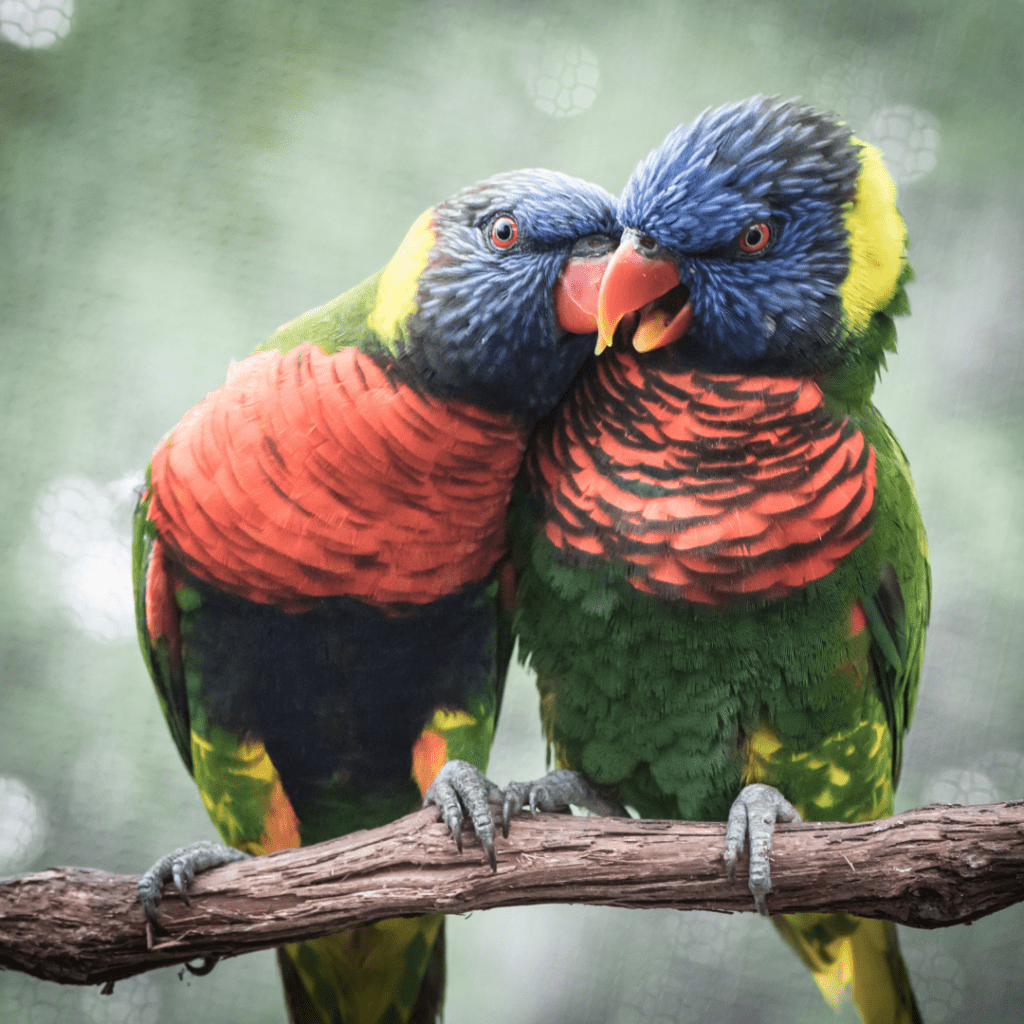Birds exhibit a range of behaviors that demonstrate their affection and care for one another. As we explore these actions, it’s important to consider whether it’s appropriate to liken them to our human understanding of kissing. Birds are thoughtful, complex, and interesting creatures. I am sure you have seen birds “kissing” each other before. So, let’s dive into the question of do birds kiss!

Do birds kiss? In the context of bird behavior, they engage in an act called “billing,” which involves beak-to-beak contact. While this intimate interaction resembles human kissing, it serves different functions related to survival, reproduction, and social bonding. Thus, it’s essential to appreciate the distinct context and purpose behind bird “kissing.”
The Science Behind Bird Affection
Affection in birds, much like in humans, serves to strengthen social bonds and ensure the survival and well-being of both partners and their offspring. Birds demonstrate their affection and care through various behaviors, such as preening and allopreening.
Preening is a behavior where birds use their beaks to clean and groom their feathers. This maintenance process helps keep their feathers in good condition, which is crucial for flight, insulation, and overall health. Preening is a self-care activity, but when it comes to bonding and expressing affection, birds engage in allopreening.
Allopreening occurs when one bird preens another, usually a mate or a close family member. It serves several purposes, such as maintaining hygiene, reinforcing bonds, and reducing stress. Allopreening is an intimate act that not only helps maintain the physical health of the recipient but also strengthens the emotional connection between the two birds.
Courtship and Mating Rituals
Before birds can engage in affectionate behaviors, they often perform elaborate courtship and mating rituals. These displays are essential for attracting and selecting a suitable mate, as they showcase the bird’s health, strength, and compatibility. Here are some common behaviors exhibited by birds during courtship and mating:
Dances: Many bird species, like the flamboyant Birds of Paradise, perform intricate dances to woo their potential partners. These dances can involve hopping, leaping, and wing-flapping, often accompanied by unique vocalizations.
Vocalizations: Birds use a variety of calls and songs to communicate with their potential mates. These vocalizations can serve as a means of attracting attention, displaying dominance, or demonstrating the singer’s health and vigor.
Displays: Some birds use visual displays to attract a mate. For example, male peafowls fan out their impressive tail feathers, creating a mesmerizing “eye-spotted” pattern. These displays often signify the bird’s good health and genetic quality.
Nest-building: In many species, the male bird is responsible for constructing a nest or a display site, known as a “bower,” to impress the female. The quality and location of the nest or bower play a significant role in the female’s mate selection process.
Gift-giving: Some birds, like the European Bittern, present gifts to their prospective mates. These gifts can be anything from food to small objects like twigs or leaves, symbolizing the bird’s ability to provide for its mate and potential offspring.
The "Kissing" Behavior
Now that we’ve covered the ways birds express affection and engage in courtship rituals let’s take a closer look at the “kissing” behavior. This intimate act, also known as “billing,” involves birds touching their beaks together.
Billing is observed in several bird species, such as swans, pigeons, and parrots. This beak-to-beak contact can serve multiple purposes, depending on the species and context. Here are some instances where birds might engage in billing:
- Pair bonding: Billing can be an essential component of pair bonding, as it helps birds establish and strengthen their connection. For example, swans engage in a beautiful “heart” display, where they curve their necks towards each other while billing. This behavior helps reinforce their monogamous relationship and signifies their commitment to each other.
- Courtship feeding: Some birds, like pigeons and doves, use billing as a form of courtship feeding. During this process, the male bird regurgitates food and transfers it to the female’s beak. This act demonstrates the male’s ability to provide for his mate and their future offspring.
- Food sharing: In some species, such as parrots, billing is a form of food sharing that can occur between mates or family members. This behavior helps to solidify social bonds and maintain group cohesion.
- Parental care: Parent birds may use billing as a way to feed their chicks. By regurgitating food into the mouths of their offspring, they ensure the young birds receive essential nutrients for growth and development.
Are The Birds Really Kissing?
As we’ve explored the various purposes behind billing and other affectionate bird behaviors, it’s important to consider whether it’s accurate to call these actions “kissing.” While there are some similarities between human kissing and bird billing—such as the close physical contact and potential exchange of food—the two behaviors serve different functions.
Human kissing is primarily a cultural expression of affection, love, or passion, while bird billing has evolved to serve specific purposes related to survival, reproduction, and social bonding. Although billing and other intimate bird behaviors can resemble kissing, it’s essential to recognize and appreciate the differences between these actions and their underlying purposes.
Is It Safe to Kiss My Bird?
Kissing your bird, though seemingly an affectionate gesture, is not recommended due to potential health risks for both you and your pet. Humans can carry bacteria, viruses, and fungi that may be harmful to birds, and birds can also carry pathogens that pose risks to humans. Additionally, the act of kissing could be stressful for your bird. Instead of kissing, consider alternative bonding activities like gentle petting, hand feeding, training, and vocal interaction to build a close and loving relationship with your feathered companion while ensuring their safety and well-being.
Frequently Asked Questions
Birds show affection to each other through various behaviors, such as allopreening, where one bird preens another, typically a mate or close family member. This intimate act reinforces bonds, maintains hygiene, and reduces stress. Birds also exhibit affection during courtship and mating rituals, which can include dances, vocalizations, and displays.
When birds appear to “kiss” by touching their beaks together, this behavior is known as “billing.” Billing serves multiple purposes depending on the species and context, such as pair bonding, courtship feeding, food sharing, and parental care.
During the mating process, some bird species engage in billing, which can resemble human kissing. However, in birds, this beak-to-beak contact typically serves specific purposes related to survival, reproduction, and bonding. For instance, courtship feeding, where the male regurgitates food and transfers it to the female’s beak, is a form of billing that demonstrates the male’s ability to provide for his mate and their future offspring.
If your pet bird appears to “kiss” you, it’s likely attempting to bond and interact with you in a way that’s familiar to its natural behaviors. However, it’s essential to recognize that birds’ “kissing” actions have different purposes and contexts than human kissing. To ensure the safety and well-being of both you and your bird, consider alternative bonding activities such as gentle petting, hand feeding, training, and vocal interaction.
Conclusion
Birds are fascinating creatures with complex social behaviors and emotional connections. While it might be tempting to anthropomorphize their actions and describe them as “kissing,” it’s crucial to understand the context and function of these behaviors in the avian world. By observing and appreciating the unique ways birds express affection and engage in courtship rituals, we can develop a deeper understanding of their lives and marvel at the beauty of nature’s love language.
So, the next time you watch a pair of birds billing or engaging in a tender allopreening session, remember that while these actions might not be “kissing” in the human sense, they represent a beautiful expression of affection and care in the bird world.
James has always been an avid outdoorsman. Since a kid, he kept a journal of all the different birds and species he saw. Now he wants to share his passion with other birders with Happy Birding!
